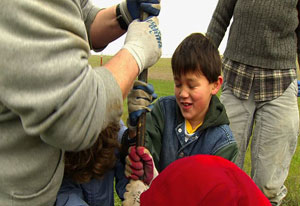 January and February are exciting months for movie buffs like me. And no, I'm not referring to Golden Globes, Oscar nominations, or Screen Actors Guild awards. I'm talking about two wonderful "green" film festivals, both right here in our own watershed: the recent Wild & Scenic Environmental Film Festival in Nevada City, and the San Francisco Ocean Film Festival.
January and February are exciting months for movie buffs like me. And no, I'm not referring to Golden Globes, Oscar nominations, or Screen Actors Guild awards. I'm talking about two wonderful "green" film festivals, both right here in our own watershed: the recent Wild & Scenic Environmental Film Festival in Nevada City, and the San Francisco Ocean Film Festival.
For The Bay Institute, this year's Wild & Scenic Film Festival was particularly exciting because it included the first public screening of "Taking Root," a film-in-progress about our STRAW (Students and Teachers Restoring a Watershed) Project. I recently talked to David Donnenfield, who is co-producing the film with Kevin White (Kevin also has two films in this year's Ocean Film Festival: Restoring Balance: Removing the Black Rat from Anacapa Island and Returning Home: Bringing the Common Murre back to Devil's Slide Rock.) I asked David how the two came to be making a movie about kids working to save an endangered freshwater shrimp.
Taking Root is part of a larger project entitled How on Earth, which began with the goal to survey the spectrum of restoration work happening across the country. David and Kevin wanted to look at projects large and small, in different regions and involving different constituencies and different issues. They also were interested in documenting projects initiated by kids-one of the things that drew them to our STRAW Project, founded in 1992 by a class of fourth-graders.
David attended film school at UCLA (after he "got the bug" while starring in a high school film), but says he was always more interested in social issues than theatrical production. As to why he finds the topic of environmental restoration of particular interest, David points to the late environmentalist David Brower's 3-part concept of "Global CPR"-- Conservation, Preservation, and Restoration. While we've all heard about conservation and preservation, David notes, "We felt that very little of the story of restoration had been told." That's a critical oversight, since "in the face of worldwide environmental decline, there is less and less to preserve but more to restore."
In talking about their process for making films, David explains that they do a lot of research up front to understand the issues, the players, and how the story fits into the "big picture." But there is also that sense of "serendipity and discovery" when they actually get out into the field, and that's a large part of what they bring back to the editing room.
